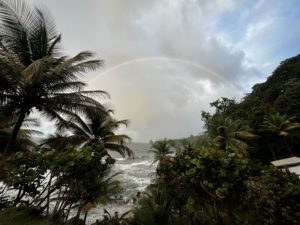Lessons of The Forest: Seeds of Belonging
– by Rheanna Chen
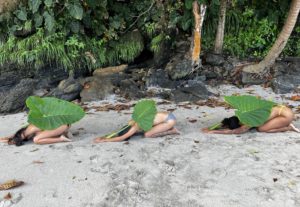
After years, I’ve finally returned home to the island that raised me since I was a baby- Trinidad, the last island of the Caribbean archipelago. For my 30th birthday in January, I felt a strong calling to visit the forest, a special place I’ve grown to adore. I couldn’t imagine a better way to start a new decade- on one of the oldest trails that connect the communities of the Northern Range mountains and the North Coast. Along with two friends, Tracy and Gesiye, we hiked for six days, across 25km and accompanied by our four-legged dog guide, “Grimey”. To carry our food rations and hammocks, I used the same backpack from my last visit in 2018. Since then, it has travelled the world with me, occasionally dropping gifts of the forest- little seeds I collected along my previous journey. In the midst of the pandemic- from Italy, France, Martinique to Barbados, they served as reminders of where I came from and where I hoped to return. As women, It was special to walk this path together- an ecosystem rich in tropical flora and fauna while infused with such meaning and a sense of belonging. No visit is ever the same; it was familiar yet different with its own lessons as the forest slowly reveals itself over time.
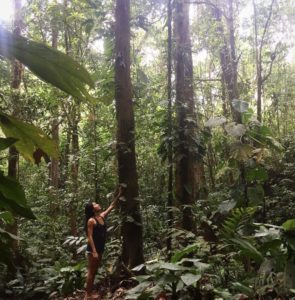
If we do not understand something, can we truly look after it? Intuitively, we think of a partner, parent or friend; yet we can extend these circles of reciprocity – mutual care, repair and maintenance- to non-human life forms, like the trees of the forest and their network of roots which connect them below the ground. In this pandemic, my generation is trapped behind a screen (thanks for reading this), where we’ve been programmed to click “like” for social media posts, where sharing “plant a tree” or “save the bee” campaigns is easier than to go outside. The reality is, how many of us feel so disconnected from nature that we don’t even know where to begin. Even with the tragic news of war and crime, we are conditioned from a pandemic habit to “keep scrolling” whereas our senses wish to come alive and have hope in humanity again. To reconnect to nature is to reconnect to parts of ourselves that are forgotten, or simply buried away waiting to be found. So let’s return to the start, where life begins. I’m not referring to the “Big Bang Theory” but rather something as small yet revolutionary as a seed.
My ethnobotany teacher once said, “the best environmentalist is the one that no-one sees; they’re quietly working, immersed in the natural world”. If this is so, then look no further than what’s often hiding below our feet, that which soil brings to life. It is extraordinary to imagine that all giants of the forest share a common beginning- they start as a seed; of which I will share only one. A favourite seed common from my island is the jumbie bead– Abrus precatorius belonging to the Fabaceae family. This brilliant red and black seed resembles a lady bug yet turns into a majestic tree, also known as the Wild Immortelle and Beau Mortel. It grows beautifully in pod-like clusters and found along the forest floor. The shell of the seed is extremely hard and almost impossible to crush with the teeth. While beautiful, they contain one of the most harmful poisons of the plant kingdom- abrin. As its seed casing is so durable, artisans have to boil the beads in order to soften them enough so they can be pierced for stringing; this act destroys the potent toxin within. The seeds are used in percussion instruments as well as for jewelry to make bracelets that supposedly ward off evil. From childhood, I’ve believed that carrying them around brings protection and safety.
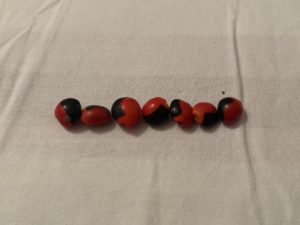
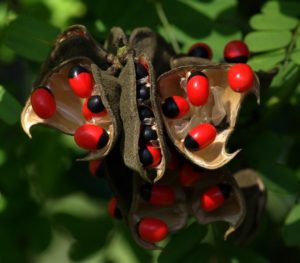
From falling out my bag, these jumbie beads are now scattered around the world- from farms, trains, bakeries to the different homes I’ve lived in. I’ve only recently returned home, after spending three years abroad. What started as a Masters in Italy and finding work turned into the pandemic with great challenges and uncertainty. However, the trail of seeds followed me wherever I went- almost like a good omen, the spirit of the forest with me, which I only befriended in recent years. I grew up in my country’s capital, Port of Spain, to a middle-class family, raised by a single father who had no interest in going on hikes or taking us to the beach. The closest I got was picking Julie mangoes and smelling jasmine flowers in my backyard. I didn’t really know my mother; she died from leukaemia suddenly when I was 4. However, I did know she was a botanist- so being close to the soil and plants, has always been a communion with her, that mother daughter connection. As I got older, I used my freedom to explore as much of my country that I felt I had missed out on. When I went to college on what felt like a noble goal to pursue environmental conservation through sustainable agriculture, it led to the sad truth that carried shame and guilt- I knew nothing about the rainforest I supposedly belonged to. Advocating against climate change and preserving biodiversity were theoretical concepts of the mind rather than lived experiences of the heart. I spent too much time studying and reading books than actually experiencing it first-hand. That epiphany left me with a deep desire to explore the dramatic coastlines and lush forests of my home, which were all strangers to me- and many others in my generation.
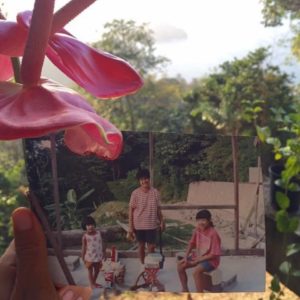
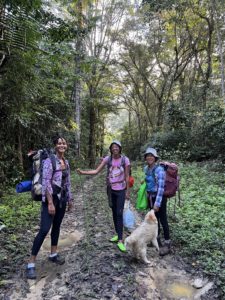
I was lucky to have my friend, Tracy, guiding the trail—a talented writer and story teller, of indigenous descent and raised in Arima. Unlike me, she inherited a knowledge of these parts of the island.
“The forests of the Northern Range have been “home” to my family for many generations. I started walking these trails at the age of four. I am now 46 and this walk felt like no other…. All along I felt like I was reconnecting with people and places, like I was somehow knitting the road back into the fabric of our lives”- Tracy
Before starting the trail, we stopped by her home to get a blessing, where her Dad pulled out the collection of camping photos from the last few decades. She came from a family that truly appreciated the natural resources of gifts the forest had to offer; she carries that understanding with her since she was a child. We began in Brasso Seco, hidden in the Northern Range of Trinidad’s oldest virgin rainforest. In the early 1900’s, it was originally a cocoa and coffee plantation; the area is rich with assorted fruit trees and surrounded by pristine rainforests full of waterfalls, clear rivers and a plethora of butterflies, mammals, birds, reptiles & insects. As Tracy has family that live along the coastline, it was almost a right of passage, from destination to the next, seeing her loved ones along the way.
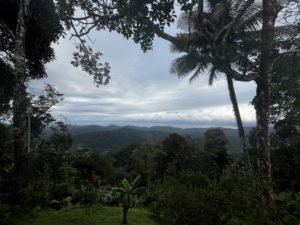
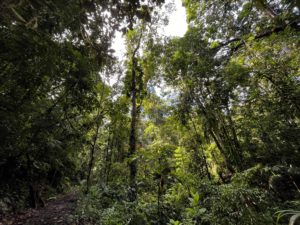
Her partner, Gesiye, a multidisciplinary artist, with roots in Nigeria and Trinidad, and raised in Maracas St. Joseph, also joined. We both grew up in the urban areas, and shared that longing to learn more about these parts of our island. As our country has high rates of crime, it is uncommon for women to wonder these parts on their own. Even the night before, we were unsure of if we continue on the trail, as two other women who were to join us were unable to. We listened to the guidance of others and committed to the journey. We walked slowly, following Tracy’s footsteps through the trail. It was not always easy; from temperatures dropping at night, to a heavy rainstorm and getting soaked, to sandflies, thorns in our feet and even hands then conditioned fears of being robbed or other predatory eyes watching us. However, we were blessed with checkpoints along the way- persons who would look after us in unexpected ways- from lighting our campfire, sharing their food and making sure we had everything we need. We were never truly alone; we were always looked after and cared for. When we would stop to take a rest, I would look down and find jumbie beads, right by my feet- those reminders that we too are seeds.
“Our connection to the spaces that we are born into gives us a sense of belonging and responsibility to that land. When that connection is impacted by trauma, such as..slavery and colonialism, we develop patterns of behaviour in relationship to the land that are then passed down through generations”- Gesiye
When I spend time in nature, I feel close to my mother, the generation before me that gave me life, since the earliest stage of the womb. When I spend time in the forest, I feel close to all mothers and all generations before me. The forest is truly a special place, like the womb of creation that stretches over time, space and all those who wonder its trails. Seeds may be small, but they are not insignificant, they have their role where the microcosm meets the macrocosm. The seeds become the trees which communicate through their network sending chemical and hormonal electrical signals. One of our teachers along the way, shared that if we pay close attention, we can hear what the forest is trying to tell us. Whether it is in the sound of the parrots, the movement of the butterflies or even the medicine of the plants. There is always more to learn. I’ll be back to the forest soon.
Until then, all we need to do is remember.
Who we are and where all of life begins.
